Final report for FNE20-952
Project Information
Project overview:
Fungus and weeds in vineyards can cause low crop yield and reduce vine vigor and longevity. This project evaluated the effectiveness, efficacy and cost savings of two technologies to control fungus and weeds without synthetic chemical: Ozonated Water for fungal control and under-vine mulch alternatives in combination with OMRI certified herbicides for weed control. Both fungal and weed control represent significant expense to East-coast vineyards.
Ozonated water:
The test program intended to utilize an automated mist system in the canopy supplied by an irrigation system to deliver a steady supply of ozonated water to the test vines. Ozone is a well-established sanitizer used by virtually every major food processor, brewery and winery in the country. Ozone gas is a very reactive compound (O3) and destroys every microbial cell with which it comes in contact. While its successful use inside manufacturing facilities is well documented, it has not been used large-scale on crops. Villa Milagro Vineyards experimented with an ozone generator on their spray tank back in 2010. The missing links were concentration (of ozone on the pathogens), timing and duration of contact. A sketch of the mist system is found in section "Other Relevant Research Information". Our original plan to test the effectiveness of Ozonated water as a fungicide was thwarted on several fronts. First COVID prevented our H2A workers from returning in March of 2020. When they did return in July, the vineyard was it total disarray and they spent the remainder of the year catching up. This left no labor available to install and test the system. The belief is that it is still a viable concept in our mind, however we were unable to complete this aspect of our proposal
OMRI certified sprays and mulch:
There are several OMRI certified herbicides that are effective. They are however, cost prohibitive if used at levels needed to produce the same weed control as conventional herbicides. This project compared alternative under-vine mulches in conjunction with two OMRI herbicides to determine effective application rates of each for weed control and comparative cost.
Our objective is to determine if it is possible, practical and economically viable to eliminate synthetic chemicals used for fungal and weed control in commercial vineyards of the Eastern US.
We intend to design and test a mist spray system within the vines' canopy that can regularly and thoroughly provide ozone to eliminate fungal disease. We will be able to use our existing drip irrigation system, with appropriate modifications to deliver the ozonated water mist. This project seeks to determine the practicality of the delivery system, its ease of operation, its ability to eliminate synthetic fungicides, its effectiveness in controlling fungal infections and its economic savings so as to be widely adopted.
We intend to test several different mulch types in conjunction with two different OMRI certified herbicides. We will evaluate which combinations effectively control weeds and compare the combined costs of the mulch, its application and upkeep and the herbicide to determine which are within an acceptable range for a commercial vineyard to adopt over synthetic herbicides.
The results of this research would be of considerable interest and economic importance to vineyard owners in New Jersey, New York, Pennsylvania, Maryland and Virginia, which are home to over 2,200 vineyards.
Vineyard owners today are looking for ways to meet consumer demand for more natural products, produced without synthetic inputs. Reducing synthetic chemical use can greatly reduce grape production costs, improve vineyard worker safety and reduce environmental impacts on soil, water quality and economical balance.
One of the largest expenses in managing a disease-free vineyard are the chemicals used for fungal and weed control. This project will seek to prove methods to eliminate or greatly reduce reliance on synthetic chemicals in both these areas of vineyard management. In addition, we feel that it is possible to simultaneously improve fruit quality - which every grower strives to do.
Fungal control:
While West Coast vineyards, which enjoy dry climates during their growing season, have a comparatively easy time accomplishing the goal of being chemical-free, it has proved elusive, if not deemed outright impossible for Eastern wine growers due to the high year-round humidity which fungal diseases favor. Three specific fungi, Downy Mildew, Powdery Mildew and Black Rot, if not controlled can destroy a crop at various stages of development, and in the case of Black Rot can weaken and destroy the vine itself.
Chemical expense, and the associated application costs (labor, fuel, tractor use) are significant expenses to commercial vineyards in the East. Additionally, it is very easy to fall off your spray routine due to bad weather, equipment breakdown and other unexpected events. Fungal disease can get a foothold the moment a spray program is disrupted, applications are made off-schedule or applications are missed at key disease infection stages . Certain times during the growing season are more critical, particularly during bloom, when spray consistency is imperative, and any interruption can have dramatically negative impacts on fruit quantity and quality.
Our proposal would test the effectiveness of in-canopy misting spray nozzles to regularly and thoroughly deliver ozonated water to the vines' foliage and fruit. By not relying on time-consuming spraying, the risk of missing a spray could be eliminated. The ozone generator would be connected to our existing irrigation system and an array of mist nozzles would be permanently embedded in the vine canopy. This method would eliminate the need for tractor use to spray, and the associated costs of maintenance and fuel, the required labor, and of course, no fungicides. Eventually the application could be automated.
Weed control:
Today, not a day goes by when we don't read something about the negative human and environmental impacts of the most widely-used vineyard herbicide, glyphosate. Nonetheless, farmers continue to use it because of its cost-effectiveness and systemic mode of action. But even these benefits may be diminished as some weeds are starting to show resistance to it. There are and have been several OMRI listed herbicides on the market for a number of years, however in order to be as effective as glyphosate their cost is roughly 20 to 30 times more, thus they have not become widely used.
With traditional fungicides and herbicides there is what's called an REI, Re Entry Interval, to be observed by workers. Even the mildest chemicals require a 12 hour REI and some as high as 72 hours, meaning that the vineyard is unsafe to enter for that time frame. If this rule is violated, unsafe labor conditions are created. In addition to the worker safety issue, REI reduces the number of hours that workers can be in the vineyard. OMRI listed herbicides have an REI of Zero, making them both worker-safe and cost-effective as workers may return to work immediately.
Our project would evaluate various under-vine mulches combined with OMRI herbicides. Some mulches are more permanent than others, and their costs vary, which is why several will be evaluated. While mulch will never be 100% effective, we feel that if it can significantly suppress weed growth, then the application of an OMRI listed herbicide, in lower concentrations at expanded intervals may be able to control weeds, thus bringing the costs in line with that of conventional herbicides and allowing more vineyards to eliminate synthetic herbicide use.
Villa Milagro Vineyards owns and operates 10 acres of vinifera (7 varieties) and one hybrid grape variety. The vineyard was established by the owners starting in 2001 with the first vines planted in 2003. At that time the owners attempted to grow their grapes organically and learned much about how to get around the traditional chemicals. after 4 years of struggling to even get a decent crop, they abandoned the idea of growing grapes organically and switched to conventional growing practices still with an eye on how to reduce chemical inputs. This is important to the owners, Steve & Audrey Gambino, because they live in the middle of the vineyard.. To date there have been no successful commercial organic vineyards east of the Mississippi River. This project was to be an extension of their commitment to finding ways to reduce or eliminate conventional chemicals in a commercial vineyard.
Cooperators
Research
Methods as Proposed
This project seeks to determine the effectiveness of mist application of ozone to control three fungal diseases that are the bane of vineyard operations: Powdery Mildew (Uncinula necator), Downy Mildew (Plasmopara viticola) and Black Rot (Guignardia bidwelli). While there are several other fungal diseases common to vineyards, these are the "Big Three" and if we can succeed with these, we will know it can control the others. Powdery and Downy affect any green tissue, interfering with photosynthesis if on leaves, and rotting fruit in severe cases. Black Rot infects the foliage and the fruit, turning the berries into dried out mummies which house spores that can be released the following year. Vineyard managers are trained to spot early symptoms of Powdery and Downy, so only in extreme cases would it get to the fruit. Black Rot is more insidious. You don't know you have it until it is too late to eradicate. It has a 10 to 14 day incubation period during which there are no visible symptoms.
One important note comparing ozone to conventional fungal sprays. Ozone is an eradicant, conventional sprays are preventive. This is relevant to the design of the canopy mist system. One of the problems with conventional sprays is that you are spraying for a target not yet seen or known. But once the fungus takes hold, it's increasingly hard to remove it. Vineyard managers tend to "over apply" their conventional synthetic chemicals just to be safe, as nobody wants to risk getting an infection.
By contrast, ozone has no residual effect, but can knock out any infection with which it comes in contact. One of the reasons our prior attempt to spray with ozone failed was that it was impossible to be in the vineyard spraying often enough to prevent disease. Our project design will eliminate the problem of having to drive the tractor frequently enough to keep diseases down, by virtue of installing mist spray heads throughout the test vines' canopy. Our protocol will determine the duration of misting required for control.
Protocol Design:
We plan to use the ozone system on two different grape varieties, one Vinifera and one Hybrid, on a portion of each type, leaving the rest of those varieties as the control. The vinifera will be Cabernet Sauvignon, (54 vines in each of 2 adjacent rows) and the hybrid will be Frontenac (16 vines in each of 3 adjacent rows). Our control vines will be the remainder of our 10 acre vineyard (which includes the remaining Cab Sav. & Frontenac) in which we will follow our established and effective conventional spray program.
How we will measure the effectiveness of the ozone mist:
Daily scouting reports with photos will be used along with counts of infected leaves in each test section to determine the level of control. With the exception of Black Rot, Powdery and Downy mildews have a very clear and visible presentation. In a conventionally sprayed vineyard, when done properly, there should be almost no evidence of either. Thus, if the ozone test fails, the contrast will be clear, and counts of infected leaves will document the statistical differences. If ozone works, the test rows will appear similar to the conventionally sprayed control rows. Black Rot is not immediately visible, but 10 - 14 days later the symptoms are clear to the naked eye, thus the same comparison will be utilized. (photos of these three fungal diseases are found in the following section)
The misting heads will be attached to the trellis wires in the test rows. (see drawing in the following section)
Weed control:
We will test 4 types of mulch combined with 2 different OMRI herbicides (8 different combinations) and compare to conventional synthetic herbicides. The test will be conducted with two rows each of the four different mulches (gravel, chopped straw, landscape fabric, wood chips/sawdust), (8 rows total). One row of each mulch type will be tested with test herbicide 1 and the other two with test herbicide 2. The remaining vineyard rows will be sprayed with our current selection of herbicides; Prowl, a pre-emergent for grasses, Chateau, a pre-emergent for broad-leaf weeds, and Cheetah, a burn-down herbicide.
Of primary concern are broad-leaf weeds which can harbor soil pathogens harmful to the vines. Both test OMRI herbicides excel at knocking down these types of weeds. Secondary concern are grasses. Because of their ryhzome nature, they are harder to control with contact herbicides, thus the popularity of systemics such as glyphosate. Our test rows will be tilled immediately before adding mulches, but not our control rows. This is because the weeds in our control rows are already under control, and tilling would actually aid in the establishment of weeds in the fresh and exposed soil.
How will we measure the effectiveness of each mulch/spray combination?
Our test is not about eradication, as there will always be some weeds or grass under the vine and a vineyard can tolerate that. It is a matter of management not annihilation. Our true test is to determine if we can achieve the same level of weed control with a test mulch/OMRI herbicide as is achieved with our current mix of herbicides. We will MEASURE the amount and frequency of our test sprays to calculate the cost. We will count the number of broad-leaf weeds per under-vine-foot in both the test and control strips to compare the effectiveness. The other measurement will be the amount of OMRI herbicide used over the course of the season to maintain the same level of weed control as a conventional program. We can then compare the costs of each mulch/OMRI herbicide combination to the costs of a conventional herbicide spray program to determine whether our model could be considered cost-effective.
We began work promptly in February 2020.
Mulches were applied.
Organic herbicides were applied one time.
In Mid-March the COVID pandemic forced us to close our tasting room. It also closed the Embassy in Mexico, and as a result our annual H2A workers were not able to return here.
Our severely limited manpower was pressed into service taking care of our vines, pruning, shoot positioning, spraying etc.
By late July we had not kept up with the organic herbicide work, had not installed the ozone mist system, at this point our workers had finally returned from Mexico, and the vineyard was way behind. It took us till late August to get it where it needed to be.
I contacted Grant Program Coordinator Candice Huber to discuss what we could do.
She informed us we could pick it up in 2021.
Being closed for 3 months and with our restaurant sales outlets still closed, we are still scrambling to stay afloat.
It is our hope that things stabilize quickly in 2021, that our workers are allowed to return from Mexico on schedule by mid-March, and we can pick up where we left off last year.
January 18, 2022 REPORT UPDATES
Summary: We were able to complete the Weed control aspect of the project but have not been able to get to the ozone component. We plan to accomplish that part in 2022.
Weed Control:
The evaluation consisted of two parts. Mulch and organic herbicide.
Mulch:
After about one year in place, the best performer was the gravel.
The fabric had separated in the center and grass from middles had grown underneath it.
The straw needed replenishment
The wood chips matted together, and were second best to the gravel.
We started the season with a spray of Avenger and BioSafe. The commercial name BioSafe uses for their herbicide is Axxe. It is available in 5 gallon and 30 gallon containers.
Over the prior year, the test rows had been invaded by thistle, very tough to kill and grew back immediately if not completely killed.
At the end of 2020 we did a conventional herbicide spray to "reset", and get ready for 2021.
The first test spray of 2021 was on 5/26 continuing with the same concentrations of Avenger (25% v/v) and Axxe (20% v/v) This spray was via hand-held spot sprayer, hitting only the sections with weeds. This is the same procedure as the prior year.
The control rows were sprayed on 4/20 with conventional herbicides. Table 1 will show amounts of each chemical for cost comparisons.
The most noticeable thing about the test rows was how fast Axxe worked. Within 3 hours those weeds treated with Axxe were black and wilted. The Avenger rows' weeds were barely wilting.
13 days post test spray:
The Avenger rows' weeds were all back and strong. The Axxe weeds remained dead, yet the thistle put out new growth around the dead ones. This is expected, as these herbicides are not systemic, like glyphosate.
Photos are attached showing the difference between herbicides.
Since the Avenger at 25% v/v was already more expensive than the Axxe at 20% v/v we concluded that the Axxe was much better and more affordable, though not yet competitive with conventional sprays.
As for the mulches they all appear to suppress the weeds with the following observations.
Gravel: the fewest weeds of the 4 mulches - still in place
Fabric: coming undone needs attention. Many spots showing earth.
Straw: could use an additional coating, starting to thin out
Chips: coverage is better than the straw, and about as many weeds.
Additional sprays were made on 6/7 on thistle only, with Axxe only.
Then the first broadcast spray with Axxe only on 8/2 and once more on 9/17.
The test rows are now as clean as the control rows.
photos below. (I am not sure I got the names of the photo's added. I attempted to type the captions UNDER each photo.)
One side benefit of the organic herbicides is that the vines do not need to be suckered prior to spraying. Suckers are new foliage sprouting from the trunks of the vine, close to the ground and in the path of the herbicide spray. Our systemic conventional sprays cannot be used if there is ANY chance of hitting this new green tissue as it is systemic, and could easily result in a dead vine. Thus, there is considerable labor saving associated with the organic herbicides which we didn't factor in, but will attempt to quantify in the cost section.
The plan for 2022 is to replace all mulches with gravel, and do only broadcast sprays with Axxe. The reason to go to broadcast spray is that spot spray is not a practical method and the usage differs considerably from the broadcast method. In order to get accurate quantity and thus, cost, comparisons we will do broadcast sprays on the test rows. We will also be able to test reduced concentrations of the mix, lowering the cost.
Currently, the organic herbicide still appears to be way more expensive than glyphosate only. However compared to our three chemical tank mix, it may be more competitive.
End of report 1/10/22
January 2023 Report follows:
Herbicide component
As reported last time, the Avenger herbicide was deemed to be too cost prohibitive at a concentration that was not as effective as the BioSafe AXXE herbicide and thus, we concluded the use of Avenger. While it is probably effective on a small scale at higher concentrations, as you will see in 2022 report Table it is roughly 17x more expensive than glyphosate over the course of a year, and still will not eliminate the weeds.
In 2022 we continued with the BioSafe AXXE. It showed promise from the perspective of killing the weeds, however as Table 2023-1 shows, it is still quite expensive as compared to traditional treatments.
In Axxe's advantage, the cost per gallon has remained stable for the past 2 years. Glyphosate and Glufosinate have both increased considerably. The Table shows current prices.
Regarding the other treatments listed in the table, as mentioned, both the Glyphosate and the Glufosinate ammonium has increased considerably in the past two years. On 11/9/21 Glyphosate 41% was $42/gallon and by 9/9/22 it was $65, a 55% increase. The Glufosinate was $57.50 / gallon on 4/5/21 and $120/gallon on 9/9/22 - a 109% increase, and several brands were not even available.
A further disadvantage of Avenger AG is that its cost had increased the most of all and is by far the most expensive of the group.
Even with the recent increases in conventional chemicals, the AXXE remains considerably more expensive. For some it may be worth it to avoid all the negatives associated with glyphosate. Glufosinate is not systemic, but the price is even less per year than the glyphosate. As for the two pre-emergent sprays tank mixed with the Glufosinate, we stopped using them because we have been planting new vines for the past few years, and were worried they would interfere with the young vines growth since they are pre emergent chemicals.
Side note: We had placed the excess gravel under one of the conventional rows, and it alone does a good job of suppressing the weeds, thus reducing the number of conventional sprays needed. We may consider covering more rows with gravel in an effort to reduce total herbicide use, whether conventional or organic.
FINAL REPORT FOLLOWS:
Ozone for Fungal control.
Between delays due to COVID, the ensuing financial hardships we experienced and problems with our supplier, we were not able to complete the Ozone test component of this project.
This spring we had begun installing the mist lines and get the ozone generator up to speed. The labor required is much more than anticipated, and every hour we spent working on the installation was an hour our workers were not tending to our vines. Once the growing season begins, it is literally a foot-race to keep up with the vines growth and to manage them through all their stages.
In addition, for some reason, our support company for the ozone system has been out of communication. We had tried to reconnect this March without much success. I had heard briefly that they were hit hard by supply chain issues of their own and were scrambling to build units for existing customers.
We were able to install mist tubing on one row of our Frontenac vines (hybrid) but since the Ozone machine was not up to speed, we didn't continue with installation. Photo attached of this one row. Although this is our final report, we do hope to pursue installation as time permits next year.
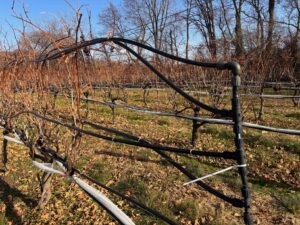
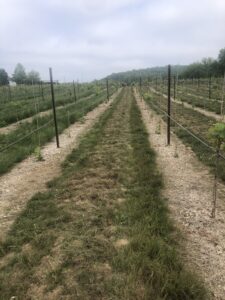
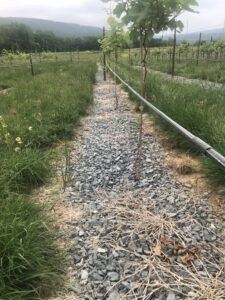

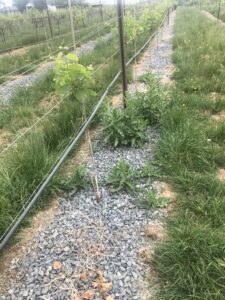
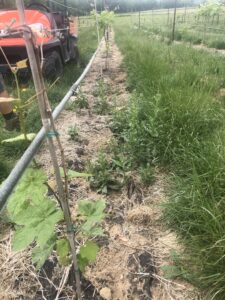
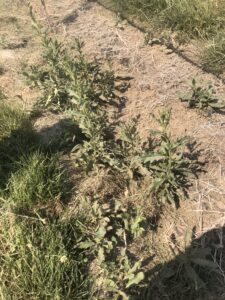
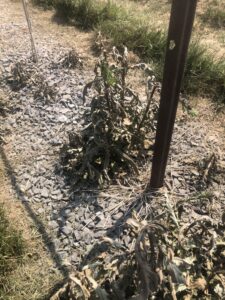
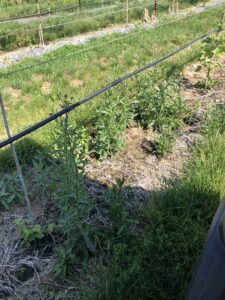
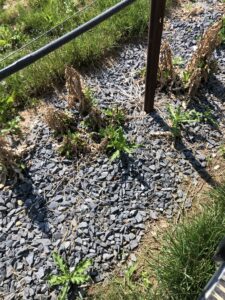
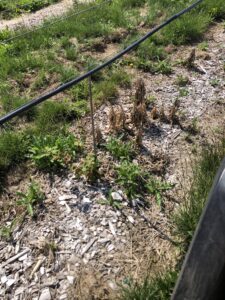
SUMMARY: OMRI Herbicide and Mulch
While the AXXE herbicide was effective, it is still cost prohibitive on a commercial scale. The tank mix is 25% v/v as compared to glyphosate which works as low as 2%. The gravel mulch was much more effective AND long-lived than any of the others attempted. We are considering using gravel in several of our other rows to reduce the overall use of conventional sprays.
SUMMARY: Ozone for Fungal control
Between delays due to COVID, the ensuing financial hardships we experienced and problems with our supplier, we were not able to complete the Ozone test component of this project.
This spring we had begun installing the mist lines and get the ozone generator up to speed. The labor required is much more than anticipated, and every hour we spent working on the installation was an hour our workers were not tending to our vines. Once the growing season begins, it is literally a foot-race to keep up with the vines growth and to manage them through all their stages.
In addition, for some reason, our support company for the ozone system has been out of communication. We had tried to reconnect this March without much success. I had heard briefly that they were hit hard by supply chain issues of their own and were scrambling to build units for existing customers.
We were able to install mist tubing on one row of our Frontenac vines (hybrid) but since the Ozone machine was not up to speed, we didn't continue with installation. Photo attached of this one row. Although this is our final report, given our long-standing commitment to organic methods, we do hope to pursue installation as time permits next year.
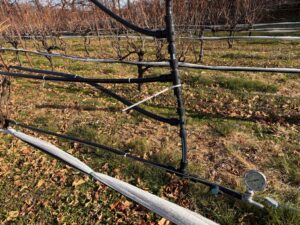 This is the manifold for one row of mist lines. There are 4 rows of lines with a solid non-mister supply line at the bottom supplying an identical manifold at the other end of the row. This is for pressure compensation, to give equal pressure and thus flow to all tubes regardless of length. The pressure gauge is to be able to calculate the flow rate. Ozone works based on concentration and quantity so it would be important to know how much is being delivered to the canopy.
This is the manifold for one row of mist lines. There are 4 rows of lines with a solid non-mister supply line at the bottom supplying an identical manifold at the other end of the row. This is for pressure compensation, to give equal pressure and thus flow to all tubes regardless of length. The pressure gauge is to be able to calculate the flow rate. Ozone works based on concentration and quantity so it would be important to know how much is being delivered to the canopy.
Education & Outreach Activities and Participation Summary
Participation Summary:
The time ran out because of the above mentioned difficulties and we were unable to complete this aspect of the project.
Above we mention tours and demonstrations. We regularly host vineyard and winery tours, and one component of those, when there is time and customer interest, was to discuss our project and show the customers what we had done and why we were doing it.
In this way, we did educate the general public, when interested. However we did not do any outreach to other producers.
Learning Outcomes
We learned several key items along the way:
- The manpower required to implement the ozone aspect was far more than we had anticipated. As small growers we just didn't have the ability to manage our vineyard AND run this test program.
- The OMRI herbicides, while effective on a small scale, are still cost-prohibitive as compared to glyphosate and glufosinate ammonium.
- The gravel mulch did an effective job of inhibiting weed growth, and we are considering adding it to several more rows in an attempt to reduce the amount of conventional herbicides we use.
- The AXXE herbicide, since it is not a systemic product, could be used to remove suckers from the trunks of the vines, which would be a reasonable labor saving method which we will try.
Project Outcomes
We learned several key items along the way:
- The manpower required to implement the ozone aspect was far more than we had anticipated. As small growers we just didn't have the ability to manage our vineyard AND run this test program.
- The OMRI herbicides, while effective on a small scale, are still cost-prohibitive as compared to glyphosate and glufosinate ammonium.
- The gravel mulch did an effective job of inhibiting weed growth, and we are considering adding it to several more rows in an attempt to reduce the amount of conventional herbicides we use.
- The AXXE herbicide, since it is not a systemic product, could be used to remove suckers from the trunks of the vines, which would be a reasonable labor saving method which we will try.
As mentioned above, we intend to continue to explore the use of Ozone as we still feel it is a viable option.
Timing is critical for the Ozone application, so the system would need to be in place before the vines emerge from dormancy. This is around April each year, based on weather. It is difficult to predict whether we can accomplish the work to have the ozone system operational in time for the 2024 growing season. If the winter weather cooperates and we can get out into the vineyard, we may be able to get it done by spring.
Gravel as mulch has shown to reduce the use of CONVENTIONAL herbicides, so we do plan to increase the number of rows where it is applied. As expected the labor to simply shovel it in place is considerable.
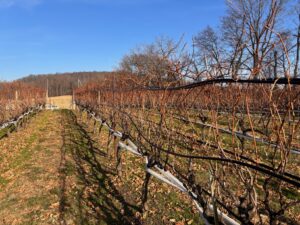
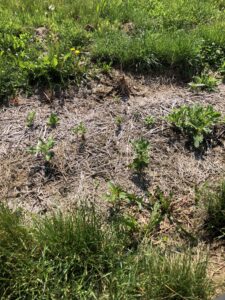 Avenger 2 @ 13 days
Avenger 2 @ 13 days